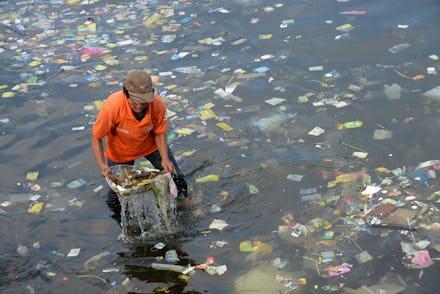There Are 700 Times More Pieces of Plastic in the Ocean Than There Are People on Earth

Plastic in our oceans might not present the immediate danger to humanity that toxic waste or fracking does, but the problem has officially reached terrifying proportions. An alarming new study released Wednesday reveals that the ocean is cluttered with 270,000 tons of plastic that is broken up to more than five trillion pieces.
The study, released in the scientific journal PLOS One, was based on more than two dozen ocean expeditions between 2007 and 2013. It was led by 5 Gyres, an organization aimed at raising awareness about the filthiness of the ocean — pollution for which we only have ourselves to blame.
Trawling more than 1,500 locations, the team collected and counted the small pieces of plastic using a mesh net while observers on boats counted the larger pieces. Computer models estimated the amount of plastic in areas researchers couldn't get to.
What did they find? Lots and lots of garbage that's having a lethal effect on the world's oceans.
"What we are witnessing in the global ocean is a growing threat of toxin-laden microplastics cycling through the entire marine ecosystem," lead author Marcus Eriksen told the Washington Post. A sizable chunk of the plastic is located in the Great Pacific Garbage Patch, a vortex of trash in the Pacific Ocean larger in surface area than the state of Texas.
The most interesting part of the survey was how the ocean's force breaks down the plastic and spreads it across the globe. The smaller pieces, between 1 and 4.75 millimeters, were the most common the scientists collected. The Southern Hemisphere, where far fewer people live compared to the Northern Hemisphere, had the same amount of plastic as the northern half of the planet. That means the ocean is whipping our garbage around the globe.
How bad is plastic? Very bad.
Plastic can wind up in the ocean in a variety of ways, including improper disposal or deliberate dumping. When that happens, the ecological consequences hurts the animals the most. Some die because they think it's food, while others suffocate from it.
It could also hurt humans too. "If we consume fish that have consumed plastic, then it is possible that we may ultimately end up eating plastic (or its chemical remnants) too," the Washington Post wrote.
Scientists warn that their estimate is "highly conservative," meaning there could be a lot more damaging plastic out there. There is also a "potentially massive amount of plastic present on shorelines, on the seabed, suspended in the water column and within organisms," the study authors write.
What can we do? Since collecting the trillions of pieces in a garbage bag isn't an option, plastic prevention starts on earth. "It is imperative that the use of plastics include a 100% recovery plan, or choose 100% environmental harmlessness in your choice of material," said Eriksen. "The status quo is no longer acceptable."
h/t New York Times